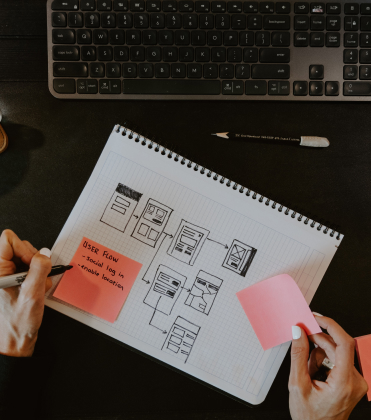
How to Effectively Use 9 Different Types of Logos?
You may be unaware of the extent to which logos influence our life. There is one in the top corner of your screen, probably one on your shoe, and an abundance of others visible.
Whether they appear on the side of a bus or as tiny icons on our screens, these brand logos are an essential asset for every firm. They serve to represent a brand's identity and distinguish it from its competitors. Not only will a good logo correctly represent the brand and its personality, but it will also be memorable and effective in a variety of scenarios. When designing a logo, you should consider the numerous forms it can take. From a single graphic symbol to plain text or various combinations of the two, here are nine sorts of logos and ideas on how to use them to build a successful design.
- Wordmarks/logotypes
- Letterforms
- Letter marks/monogram logos
- Logo symbols/brand marks/pictorial marks
- Abstract logo marks
- Mascots
- Emblems
- Combination marks
- Dynamic Marks
- Wordmarks/logotypes: -
Wordmarks (also known as logotypes) comprise a company's name in a specific typeface. Steve Jobs once stated, "Simple might be more difficult than complicated." To understand how to create a logo correctly, you must pay close attention to every element. If you're going for a wordmark or text logo, you have several options. Some companies, such as Coca-Cola, design a typeface just for their logo. This, however, requires time and the expertise of a professional designer. Alternatively, you might select a logo typeface that matches the spirit of your brand. In general, modern logo designs will employ a sans serif font, although fashionable logo designs may demand more intricate typefaces. Consider whether to use all capital letters, small letters, or a combination, and whether to use any special characters or colors in your logo.
Wix, Coca-Cola, Subway, Casper, Kellogg's, eBay, and West Elm are among the examples.
- Letterforms: -
Letterforms are logos consisting of merely the initial letter of a company's name. Frequently, brands will have an alternate version of their logo that includes their whole business name (termed a wordmark or logotype, as previously stated), to be used in different situations.
Letterform logos are easily scalable due to their modest size. They are likely to remain recognizable even when shrunk to minuscule proportions, especially if their design is straightforward and devoid of excessive details. This makes them great for app icons, favicons, and other social media profile images. In general, letterform logos are a fantastic option for well-known firms. Otherwise, it can be difficult to persuade people to recognize and recall your company's name. Additionally, they benefit brands with lengthy names.
Facebook, McDonald's, Netflix, Pinterest, Uber, and Beats are among the examples.
- Letter marks/monogram logos: -
Lettermarks (sometimes known as monogram logos) are typographic logos comprised of the initials of a brand. Typically, brands with monogram logos, such as IBM and NASA, are referred to by their abbreviated form while speaking (when was the last time you heard someone say National Aeronautics and Space Administration).
Like the previously stated logo kinds, letter marks can be created utilizing a custom typeface or by locating a font that effectively communicates your business identity. Consider several typographic settings, such as kerning (the space between letters), width, weight, and style (such as bold or italic).
In certain industries, it is customary practice for brands to utilize their abbreviated names. If you are functioning within these parameters, you may want to build a lettermark logo. Letter marks are also a typical choice for brands with lengthy names who wish to make a reduced version more memorable.
HBO, IBM, NASA, CNN, HP, and Louis Vuitton are some examples.
- Logo symbols/brand marks/pictorial marks: -
Logo symbols (also known as brand markings or pictorial marks) are graphical icons, symbols, or images that represent the identity or activity of the brand. Typically, these types of logos symbolize a real-world thing. Some of the most effective logos employing symbols are those that immediately convey the brand's identity. Consider what will represent your brand if you opt to go with a graphical logo. Do you want it to be an exact reflection of your name, like Apple? It can also be utilized to gently suggest the ideals or message of your brand. Notice, for instance, how Twitter's bird represents hope and freedom by facing upwards. Finding the ideal image for your logo symbol might be difficult, especially if your brand is new. Not only are you likely to expand, evolve, and add the latest items over time, but it may also take people some time to remember your logo and associate it with your brand. Consider adding your name to the logo in this instance (see combination marks below).
In addition to selecting a symbol that evolves with your brand, a crucial logo design tip is to guarantee that your design is ageless. While it may be tempting to design a trendy and "of the moment" illustrative logo, you do not want to have to produce a new logo a few months later to remain relevant.
A benefit of employing these types of logos is that they aid in establishing a powerful tone of voice. Once your organization becomes well-known, a well-designed logo symbol can become quite memorable.
Shell, Apple, Twitter, Target, Instagram, Snapchat, and Major League Baseball are examples.
- Abstract logo marks: -
These are image-based logos that incorporate abstract forms to convey a company's brand. In contrast to pictorial logos, which depict a physical item, abstract logos are more metaphorical. Since they do not depict a single recognizable object, abstract logo marks allow you to develop something truly distinctive. If you use this sort of logo, you should emphasize your brand's key values. Experiment with reflecting them in a basic, geometric shape that evokes the appropriate feelings and messages. In addition to resembling the letter 'A', for instance, Airbnb's logo is suggestive of the recognizable 'location' sign and is an abstract representation of an upside-down heart. If you decide to create this style of a logo, ensure that your brand identity is established and that you know precisely what you want to communicate to your audience. In addition, an abstract logo mark may be ideal for multinational firms whose names do not translate effectively between languages.
Airbnb, Chanel, Nike, the Olympics, Google Drive, Adidas, and Pepsi are among the examples.
- Mascots: -
Mascot logos consist of graphical characters that serve as "ambassadors" or visual representations of a business. If they fit the brand's essence, they can be anything from fictional characters to actual people. People have a natural affinity for other individuals and fictional characters, which makes mascots a useful tool for fostering consumer engagement. You can also employ a mascot to create a pleasant, lively atmosphere that will appeal to your audience, which is why children's and family-oriented businesses frequently use this style of logo. Consider whether a mascot is appropriate for your business and, if so, how you might utilize it to convey the right message. Mascots can be useful in creating social media and marketing initiatives because of their welcoming and engaging nature. Note, however, that they are frequently comprised of more features than a typical logo, and so may require a simplified version for small dimensions, such as favicons and business cards.
Examples: Mr. Peanut by Planters, Cap'n Crunch, Tony the Tiger by Kellogg's, and the Michelin Man by Michelin.
- Emblems: -
Typically, emblems, also known as badge logos, resemble crests. They use text and symbolic imagery to create elaborate, conventional designs.
Consider your industry when deciding whether an emblem is appropriate for your business. While there are no restrictions, universities, sports teams, and coffee brands favor this style of emblem. A current logo style is a modern interpretation of the emblem that favors a more minimalist approach, typically involving vector images and clean lines.
Emblems can also provide space for a statement that reflects the message of your brand. When designing an emblem, you should keep in mind that elaborate details can make this form of logo less adaptable and less effective in smaller sizes. In such circumstances, a simpler solution can be developed.
Starbucks, Stella Artois, Harley-Davidson, the NFL, Warner Brothers, and Manchester United are some examples.
- Combination marks: -
Some brands have one main logo in the form of a combination mark, while occasionally splitting up the text and imagery to better suit various contexts. Combination marks are immensely popular amongst brands from all industries, as they are extremely versatile. You can create several variations of your logo and use them for different purposes while ensuring clear and cohesive visual language throughout. For example, notice how Lacoste uses their combination mark on their website design, while most of its products only feature the much-loved and recognizable green crocodile. For companies that are not yet well-known, combination marks can be a great starting point, helping you build brand recognition. With time, you will have the freedom to use just the text or just the icon, while remaining recognizable. Also, supporting the text with icons, symbols and other forms of imagery helps potential customers understand what your brand is all about.
Examples: Taco Bell, Toblerone, Dropbox, CVS,
- Dynamic Marks: -
Dynamic logos are a bit of an anomaly when it comes to knowing the many sorts of logos and which one is best for you, given that they can take on a variety of forms. Even though consistency is a fundamental rule of logo design, this is precisely what makes dynamic logos so versatile. Consistency is the key to the success of dynamic logos. These types of logos require a basic framework that acts as the logo's central motif and is present in all variations. Consider, for instance, when you open your Google browser and the familiar wordmark logo is suddenly adorned with historical people, events, or celebrations, but you still recognize it as Google. Its brand is powerful enough to change its identifiable emblem into many forms that are not only timely and relevant but also continue to reinforce its brand messaging. b Hillary Clinton's 'H' logo is another excellent example of a dynamic mark. In its original version, the logo has a patriotic red, white, and blue color scheme, which has evolved into a variety of additional color schemes that have helped represent her campaign message and basic principles in a phenomenally successful manner.
These examples demonstrate that a dynamic logo is not merely a random assortment of icons or pictures thrown together hurriedly, but the result of a careful and intentional design approach that effectively conveys the essence of a business.
This is especially useful for brands that are dynamic. If you work in a creative field and wish to remain original and fresh, this style of the logo may be ideal. However, try not to go overboard with regular changes and alterations of your logo, as you want clients to maintain favorable associations with your brand as they begin to recognize it. Always keep in mind that regardless of the style of logo you choose, consistency is essential.
MTV, Hillary Clinton, Google, Nickelodeon, and Virgin are some examples.
Regardless of the sort of logo you select, keep in mind that thoughtful design can not only improve your brand, but also ensure that people will remember your logo for a long time. Over time, consumers will develop favorable associations with your logo and brand, resulting in an increase in value and trust.
Now that you know which style of logo best suits your needs, it is time to design one. Our logo generator allows for extensive customization of text, typography, colors, and shapes. Using this free tool, you may experiment with numerous sorts of logos to create the ideal one.



